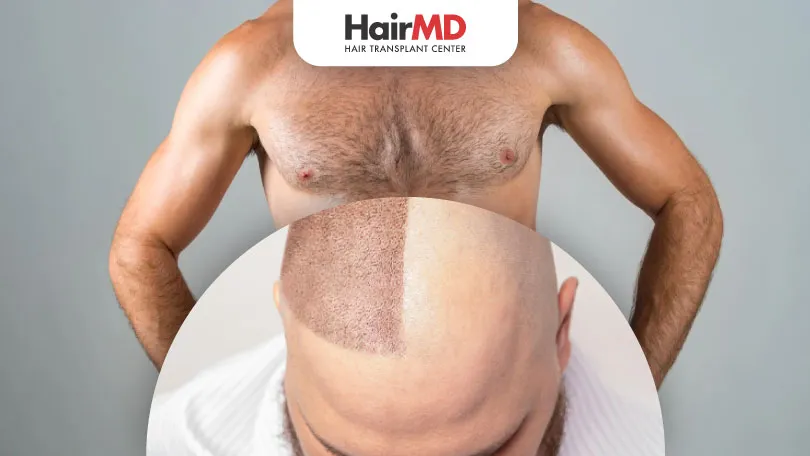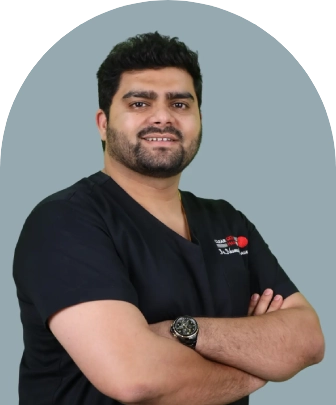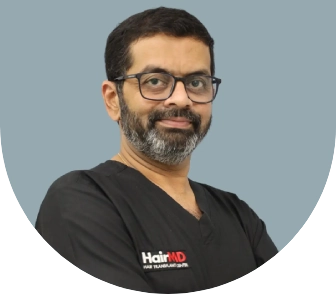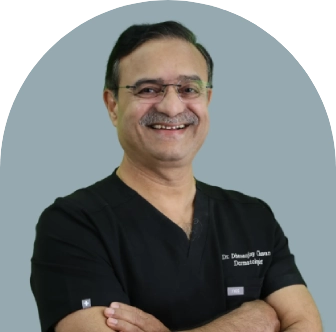20th Dec, 2021

Have you ever wondered if you can use hair from your body, like your chest or back, to fill in bald spots on your head? In this article, we’ll explore the possibility of body hair to scalp transplants. Many people face hair loss for various reasons, and traditional methods often focus on scalp hair. But what if hair from other parts of your body could help?
We’ll dive into how this process works, its benefits, and whether it’s a viable option for those looking to restore their hair. Let’s uncover the possibilities together!
What’s covered in the article?
- Is Body Hair to Scalp Transplant Possible?
- What is a Body Hair Transplant?
- Can Hair Be Transplanted From the Body to the Scalp?
- Which Body Area Hair Can Be Used for a Hair Transplant?
- Body Hair Transplant Guide
- Body Hair Transplant Aftercare
- Recovery Time After Body Hair Transplant
- Why Expertise for Body Hair Transplant Is Required?
- Why Choose HairMD, Pune for a Hair Transplant?
- Conclusion
Is Body Hair to Scalp Transplant Possible?
Have you ever wondered if hair from your body could be used to fill in the thinning spots on your scalp? It’s an interesting idea, especially for those who are experiencing hair loss or want to restore a fuller look to their hair.
We’ll look at how the process works, what you can expect, and whether it’s a good option for you. No need to worry about complicated medical terms—everything will be explained in simple, easy-to-understand language.
What is a Body Hair Transplant?
A body hair transplant involves taking hair from various parts of your body, such as the chest, back, arms, or legs, and transplanting it to areas on your scalp where the hair is thinning or missing. This procedure can be a viable option for individuals who lack sufficient donor hair on their scalp.
Techniques: FUT and FUE
There are two primary techniques used for body hair transplants:
Follicular Unit Transplantation (FUT): In this method, a strip of skin containing hair follicles is removed from the donor area. The hair follicles are then extracted from the strip and transplanted to the target area on the scalp. Although this technique can leave a linear scar, it allows for the transplantation of a significant number of follicles in a single session.
Follicular Unit Extraction (FUE): This technique involves removing individual hair follicles directly from the donor area using a specialised tool. The follicles are then transplanted to the scalp. FUE(Follicular Unit Extraction) is less invasive than FUT and does not leave a noticeable scar, although it might require multiple sessions depending on the extent of the hair transplant needed.
Can Hair Be Transplanted From the Body to the Scalp?
Yes, it is indeed possible to transplant body hair to the scalp.
This procedure, known as Body Hair Transplantation (BHT), involves taking hair from various parts of the body such as the chest, back, or even legs and transplanting it to the scalp where hair is thinning or missing. This technique is particularly useful for individuals who may not have sufficient donor hair available on their scalp.
Body hair can differ slightly in texture and growth patterns compared to scalp hair, but skilled surgeons can blend these hairs seamlessly to achieve a natural-looking result. The process involves harvesting individual hair follicles from the donor area using a method called Follicular Unit Extraction (FUE).
These follicles are then carefully implanted into the scalp. The success of the procedure hinges on factors such as the surgeon’s expertise, the quality of the donor hair, and the patient’s individual hair characteristics.
While BHT can be a viable solution, it’s crucial to consult with a qualified hair restoration specialist to determine if it’s the right option for your specific needs.
Which Body Area Hair Can Be Used for a Hair Transplant?
Beard
Hair from the beard is often a preferred choice for transplantation due to its coarse texture and robust growth characteristics. Beard hair can be used to fill in areas of the scalp where thicker hair is desired, such as the crown or areas with significant thinning.
Chest
The chest can provide a substantial amount of donor hair, especially in individuals with dense chest hair. Chest hair tends to be finer and curlier compared to scalp hair, but it can work well for filling areas that need less volume.
Abdomen
Hair from the stomach area can also be used for transplantation. Although not as commonly utilised as beard or chest hair, stomach hair can be a supplementary source when additional donor hair is needed.
Legs
Leg hair, like other body hair, can vary considerably in texture and thickness. It is generally used as a last resort due to the significant difference in growth patterns compared to scalp hair. However, in certain cases, it can provide the necessary supply for transplantation.
Pubic Area
Hair from the pubic area is typically coarser and sometimes used for transplant purposes. Given its texture, it may be suitable for specific regions of the scalp where coarser hair is needed. However, it is not commonly used due to the sensitive nature of the donor area.
Armpits
Armpit hair tends to be shorter and curlier compared to other body hair. While it is less commonly used, armpit hair can still serve as an additional source of donor hair when other areas are insufficient.
Each of these body areas offers unique characteristics that can be matched with the requirements of the recipient area on the scalp. The choice of donor site will depend on the individual’s hair characteristics and the specific needs of the transplant. Consulting with a qualified hair transplant surgeon is crucial to determine the most suitable options for a successful hair transplant.
Body Hair Transplant Guide
Step 1: Consultation and Preparation
The first step in a body hair transplant process is a thorough consultation with a qualified hair transplant surgeon. During this consultation, the surgeon will assess the individual’s hair characteristics, donor site suitability, and overall health to determine candidacy for the procedure. Preparation may include pre-operative instructions such as avoiding certain medications or refraining from smoking.
Step 2: Hair Follicle Removal
Once the donor areas are identified, the surgeon will proceed with the extraction of hair follicles. Using a specialised instrument, the follicles are carefully removed from areas such as the beard, chest, stomach, legs, pubic area, or armpits. This process is known as Follicular Unit Extraction (FUE) and is performed under local anaesthesia to minimise discomfort.
Step 3: Grafting
After the hair follicles have been extracted, they are meticulously sorted and prepared for implantation. This careful sorting ensures that the healthiest and most suitable follicles are selected for the transplant, maximising the chances of successful grafting and natural-looking results.
Step 4: Incisions
The next step involves making precise incisions in the recipient area on the scalp. These incisions are strategically placed to match the natural hair growth pattern, ensuring that the transplanted hair blends seamlessly with the existing hair. The size and angle of each incision are critical for optimal integration.
Step 5: Implanting
The sorted follicles are then gently placed in the incisions carefully considering the density required in particular areas.
Step 6: Post-Operative Care
Proper post-operative care is essential for the success of a body hair transplant. The surgeon will provide detailed instructions on how to care for the transplanted area, including guidelines for washing, medication, and avoiding strenuous activities. Following these instructions diligently can significantly enhance the healing process and the final outcome.
Step 7: Follow-Up
Follow-up visits with the surgeon are vital to monitor progress and address any concerns that may arise. These visits allow the surgeon to evaluate the growth of the transplanted hair, ensure proper healing, and make any necessary adjustments to the post-operative care regimen. Follow-up care is an important part of achieving long-lasting and satisfactory results.
Body Hair Transplant Aftercare
Rest and Relaxation
Adequate rest and relaxation play a crucial role in the recovery process after a body hair transplant. It is highly recommended to take it easy for the first few days following the procedure to allow your body to heal properly. Avoid any strenuous activities or heavy lifting during this period to prevent any unnecessary stress on the transplanted areas.
Washing and Shampooing
Proper washing and shampooing are vital to ensure that the transplanted hair follicles remain clean and free from infection. Typically, you will be advised to wait a couple of days before washing your hair. Use a gentle, sulphate-free shampoo and follow the surgeon’s instructions carefully on how to wash your hair without disturbing the grafts.
Scalp Care
Caring for the scalp is essential to avoid any complications and ensure optimal healing. Avoid scratching or rubbing the scalp, as this can dislodge the grafts. Applying any recommended topical treatments or ointments as directed by your doctor can help soothe the scalp and promote healing.
Swelling and Elevation
Swelling is a common side effect post-transplant, usually around the forehead and eyes. To minimise swelling, it’s advisable to sleep with your head elevated for the first few nights. Cold compresses can also be applied to the forehead (avoiding direct contact with the grafts) to further reduce swelling.
Hydration
Staying well-hydrated aids in the recovery process and supports overall health. Drinking plenty of water and maintaining a balanced diet will help your body heal more efficiently. Adequate hydration can also promote healthy skin and hair growth, which is beneficial for the transplanted follicles.
Avoid Certain Activities
For the first few weeks, it’s important to avoid activities that could compromise the newly transplanted hair. This includes refraining from swimming, especially in chlorinated pools, heavy exercise, and exposure to excessive heat or sunlight. These activities can affect the healing process and the survival of the grafts.
Recovery Time After Body Hair Transplant
Recovery time after a body hair transplant can vary depending on individual healing rates and the extent of the procedure. Generally, patients can expect initial healing within two weeks, during which minor swelling and redness around the transplanted area may subside.
The newly transplanted hair will go through cycles of shedding and regrowth, which is a normal part of the recovery process. Full results and noticeable hair growth can typically be seen within six to twelve months post-procedure.
Adhering to your surgeon’s aftercare instructions is crucial for ensuring a smooth recovery and achieving the best possible outcome.
Why Expertise for Body Hair Transplant Is Required?
Undergoing a body hair transplant is a delicate and intricate procedure that demands a high level of skill and experience. Expert surgeons are well-versed in the complexities of hair transplant techniques and understand the nuanced differences between body hair and scalp hair. This expertise is crucial for several reasons:
Precision in Extraction and Implantation
Precision is key in both the extraction and implantation phases of a body hair transplant. Expert surgeons are adept at using advanced tools and techniques to carefully extract hair follicles from donor areas with minimal damage. Proper implantation ensures that the hair grows in a natural direction and pattern, which is vital for achieving aesthetically pleasing results.
Minimising Risks and Complications
An experienced surgeon can effectively minimise the risks and complications associated with the procedure. This includes reducing the chances of infection, scarring, and graft rejection. Their expertise allows them to anticipate and address potential issues promptly, ensuring a smoother recovery process for the patient.
Tailored Treatment Plans
Expert surgeons can create customised treatment plans tailored to the specific needs and goals of each patient. They assess various factors such as hair type, skin condition, and overall health to recommend the best approach. This personalised care increases the likelihood of a successful transplant and satisfying results.
Consistency in Results
Experience and skill contribute to the consistency and reliability of the outcomes. Expert surgeons have a proven track record of successful body hair transplants, providing patients with confidence in the procedure. They are adept at handling a range of cases, from straightforward to complex, ensuring optimal results for each individual.
By choosing a surgeon with specialised expertise in body hair transplants, patients can ensure they receive the highest standard of care, leading to the best possible outcomes and a more confident appearance.
Why Choose HairMD, Pune for a Hair Transplant?
HairMD stands out as the premier choice for body hair transplants for several compelling reasons. First and foremost, we pride ourselves on having a team of highly experienced surgeons who specialise in the latest techniques and practices in hair transplantation. Our Hair Transplant Doctors are not only skilled but also consistently updated with advancements in the field, ensuring they deliver cutting-edge solutions to our patients.
Moreover, HairMD offers personalised care tailored to your unique requirements. From the initial consultation to post-procedure follow-ups, we provide a bespoke treatment plan that addresses each patient’s specific needs and expectations. This meticulous attention to detail ensures both aesthetically pleasing and natural-looking results.
We also use state-of-the-art technology and equipment to optimise the success of the hair transplant procedure. Our clinic is equipped with the latest innovations in hair restoration, which allows us to perform procedures with a high degree of precision and minimal discomfort. Patients can anticipate a smoother recovery experience and a quicker return to their daily activities.
In addition to our technical proficiency, we believe in fostering a supportive and transparent relationship with our patients. From discussing potential outcomes to addressing any concerns, our team is dedicated to ensuring you feel informed and confident throughout your hair restoration journey.
Choosing HairMD Pune means opting for quality, expertise, and a patient-centred approach that prioritises your satisfaction and well-being. With our proven track record of successful transplants and consistent patient satisfaction, you can trust HairMD to help you achieve the look you desire.
Do You Know?
Nearly 250 Patients Visit HairMD
Everyday For Various Hair Concerns?
(Your journey to healthier and fuller hair starts here!)
Meet Our Dermatologists
Conclusion
In conclusion, body hair transplants offer a promising solution for those facing hair loss, especially when scalp hair is limited. By using hair from areas like the beard, chest, or legs, skilled surgeons can create a fuller, more natural-looking hairline. It’s essential to understand the process, from the initial consultation to post-operative care, to ensure a successful outcome.
If you’re considering this option, consult with an experienced professional like HairMD in Pune, where you’ll receive personalized care and expert guidance tailored to your needs. With the right support, you can confidently restore your hair and enhance your appearance!
Further Reading
Oily Scalp After Hair Transplant and How to Manage It
Oily scalp after hair transplant is common and manageable. Get simple care tips to reduce oiliness and support a smooth recovery.
Hair Transplant Myths & Facts
Uncover the truth behind common myths about hair transplants. Learn the facts about the procedure, recovery, results, and who makes an ideal candidate for a successful transplant.
How to remove scabs after Hair Transplant? | HairMD
The correct way to remove scabs after hair transplant without damaging grafts. Get expert-backed tips from HairMD Pune to support a smooth recovery.
Shedding Phase After Hair Transplant
Discover essential medications post-hair transplant like finasteride and minoxidil. Learn tips for care and recovery from HairMD Pune experts.
Have thoughts? Please let us know
We are committed not only to treating you, but also educating you.










